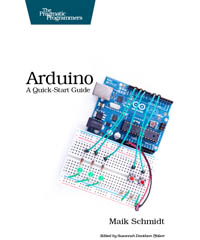

Most ebook files are in PDF format, so you can easily read them using various software such as Foxit Reader or directly on the Google Chrome browser.
Some ebook files are released by publishers in other formats such as .awz, .mobi, .epub, .fb2, etc. You may need to install specific software to read these formats on mobile/PC, such as Calibre.
Please read the tutorial at this link. https://ebooknice.com/page/post?id=faq
We offer FREE conversion to the popular formats you request; however, this may take some time. Therefore, right after payment, please email us, and we will try to provide the service as quickly as possible.
For some exceptional file formats or broken links (if any), please refrain from opening any disputes. Instead, email us first, and we will try to assist within a maximum of 6 hours.
EbookNice Team

Status:
Available0.0
0 reviews
ISBN 10: 1934356662
ISBN 13: 9781934356661
Author: Maik Schmidt
Arduino is an open-source platform that makes DIY electronics projects easier than ever. Gone are the days when you had to learn electronics theory and arcane programming languages before you could even get an LED to blink. Now, with this new edition of the bestsellingArduino: A Quick-Start Guide, readers with no electronics experience can create their first gadgets quickly. This book is up-to-date for the new Arduino Zero board, with step-by-step instructions for building a universal remote, a motion-sensing game controller, and many other fun, useful projects.
This Quick-Start Guide is packed with fun, useful devices to create, with step-by-step instructions and photos throughout. You'll learn how to connect your Arduino to the Internet and program both client and server applications. You'll build projects such as your own motion-sensing game controller with a three-axis accelerometer, create a universal remote with an Arduino and a few cheap parts, build your own burglar alarm that emails you whenever someone's moving in your living room, build binary dice, and learn how to solder. In one of several new projects in this edition, you'll create your own video game console that you can connect to your TV set.
This book is completely updated for the new Arduino Zero board and the latest advances in supporting software and tools for the Arduino. Sidebars throughout the book point you to exciting real-world projects using the Arduino, exercises extend your skills, and "What If It Doesn't Work" sections help you troubleshoot common problems.
With this book, beginners can quickly join the worldwide community of hobbyists and professionals who use the Arduino to prototype and develop fun, useful inventions.
Part I. Getting Started with Arduino
1. Welcome to the Arduino
What You Need
What Exactly Is an Arduino?
Exploring the Arduino Board
Installing the Arduino IDE
Meeting the Arduino IDE
Hello, World!
Compiling and Uploading Programs
What If It Doesn’t Work?
Exercises
2. Creating Bigger Projects with the Arduino
What You Need
Managing Projects and Sketches
Changing Preferences
Using Serial Ports
What If It Doesn’t Work?
Exercises
Part II. Eleven Arduino Projects
3. Building Binary Dice
What You Need
Working with Breadboards
Using an LED on a Breadboard
First Version of a Binary Die
Working with Buttons
Adding Your Own Button
Building a Dice Game
What If It Doesn’t Work?
Exercises
4. Building a Morse Code Generator Library
What You Need
Learning the Basics of Morse Code
Building a Morse Code Generator
Fleshing Out the Morse Code Generator’s Interface
Outputting Morse Code Symbols
Installing and Using the Telegraph Class
Publishing Your Own Library
What If It Doesn’t Work?
Exercises
5. Sensing the World Around Us
What You Need
Measuring Distances with an Ultrasonic Sensor
Increasing Precision Using Floating-Point Numbers
Increasing Precision Using a Temperature Sensor
Creating Your Own Dashboard
What If It Doesn’t Work?
Exercises
6. Building a Motion-Sensing Game Controller
What You Need
Wiring Up the Accelerometer
Bringing Your Accelerometer to Life
Finding and Polishing Edge Values
Building Your Own Game Controller
More Projects
What If It Doesn’t Work?
Exercises
7. Writing a Game for the Motion-Sensing Game Controller
Writing a GameController Class
Creating the Game
What If It Doesn’t Work?
Exercises
8. Generating Video Signals with an Arduino
What You Need
How Analog Video Works
Building a Digital-to-Analog Converter (DAC)
Connecting the Arduino to Your TV Set
Using the TVout Library
Building a TV Thermometer
Working with Graphics in TVout
What If It Doesn’t Work?
Exercises
9. Tinkering with the Wii Nunchuk
What You Need
Wiring a Wii Nunchuk
Talking to a Nunchuk
Building a Nunchuk Class
Using Our Nunchuk Class
Creating Your Own Video Game Console
Creating Your Own Video Game
What If It Doesn’t Work?
Exercises
10. Networking with Arduino
What You Need
Using Your PC to Transfer Sensor Data to the Internet
Registering an Application with Twitter
Tweeting Messages with Processing
Communicating Over Networks Using an Ethernet Shield
Using DHCP and DNS
What If It Doesn’t Work?
Exercises
11. Creating a Burglar Alarm with Email Notification
What You Need
Emailing from the Command Line
Emailing Directly from an Arduino
Detecting Motion Using a Passive Infrared Sensor
Bringing It All Together
What If It Doesn’t Work?
Exercises
12. Creating Your Own Universal Remote Control
What You Need
Understanding Infrared Remote Controls
Grabbing Remote Control Codes
Cloning a Remote
Controlling Infrared Devices Remotely with Your Browser
Building an Infrared Proxy
What If It Doesn’t Work?
Exercises
13. Controlling Motors with Arduino
What You Need
Introducing Motors
First Steps with a Servo Motor
Building a Blaminatr
What If It Doesn’t Work?
Exercises
arduino quick start guide
arduino a quick-start guide pdf
arduino a quick-start guide 2nd edition pdf
arduino starter guide pdf
arduino 101 beginners guide pdf
Tags: Maik Schmidt, Arduino, Guide